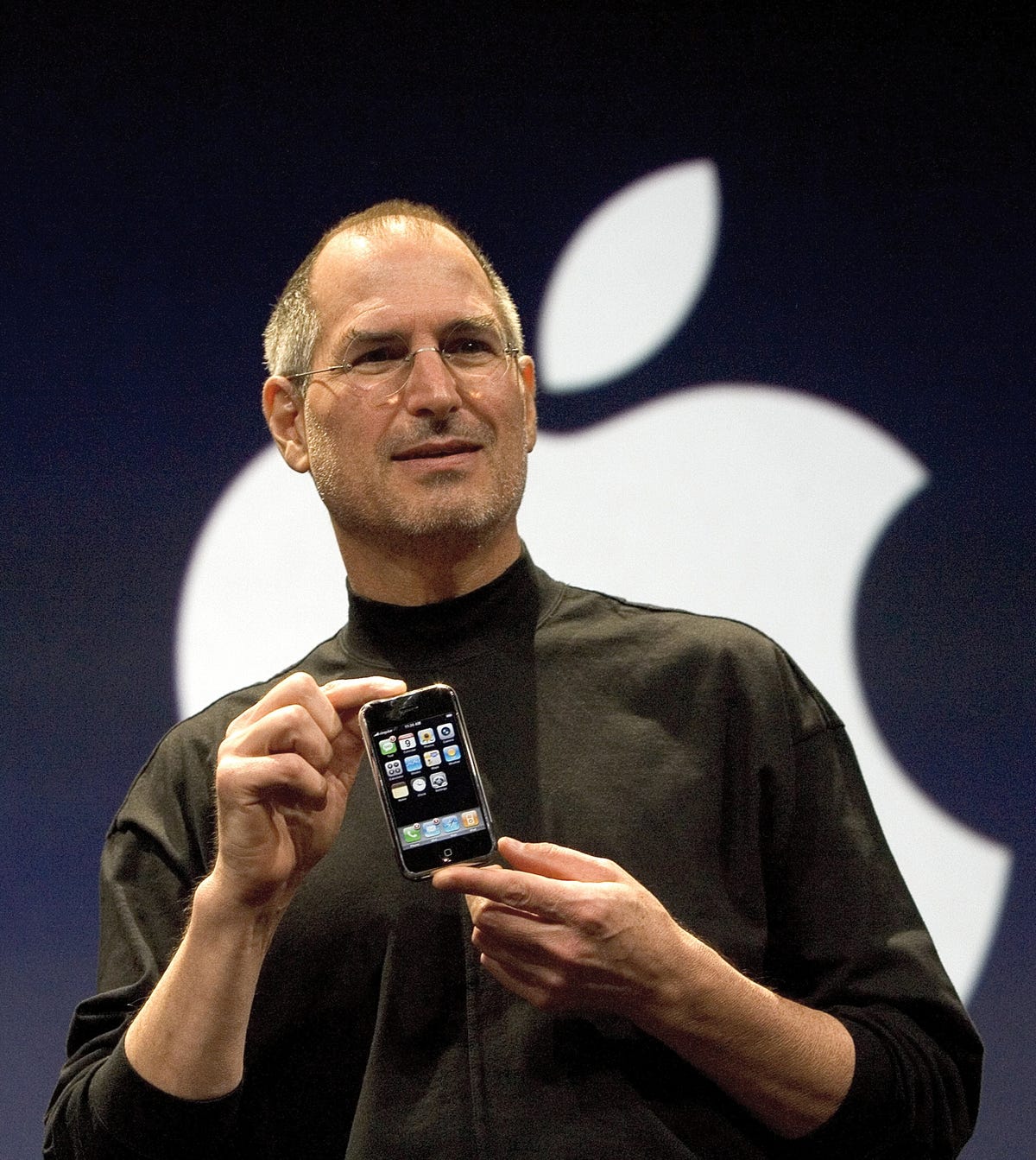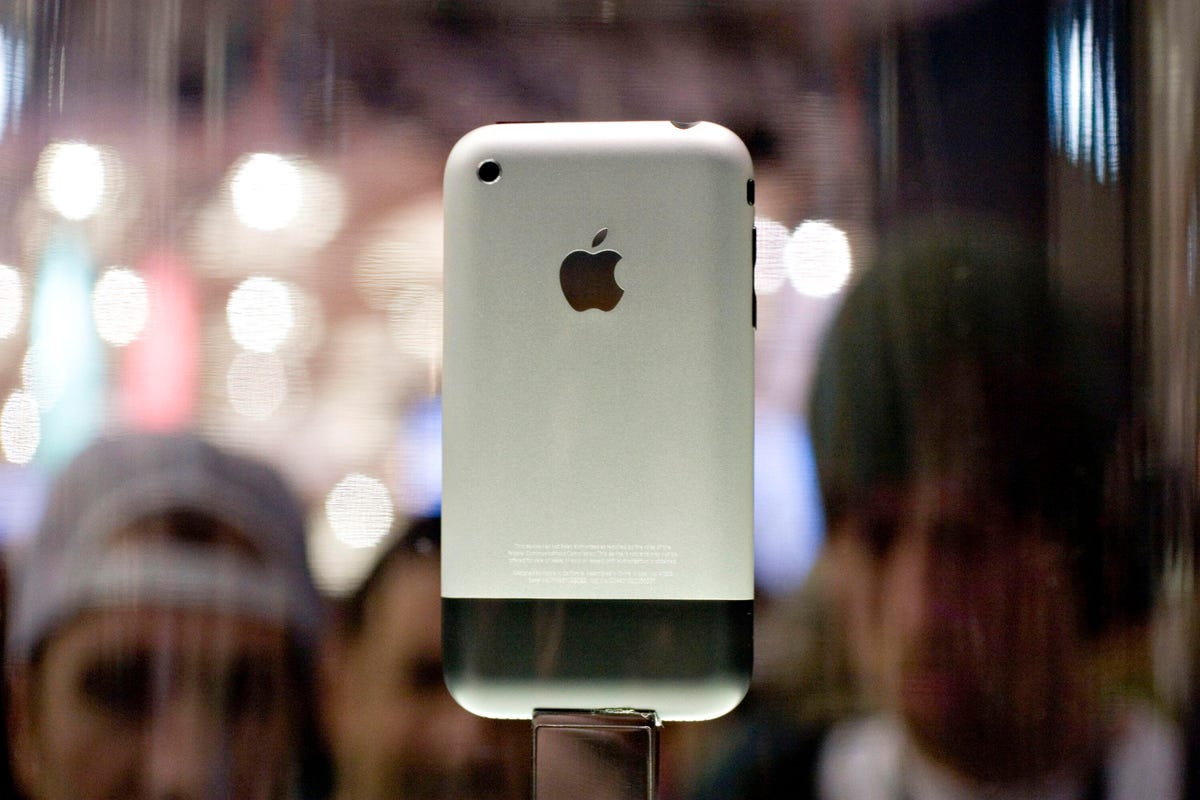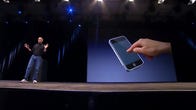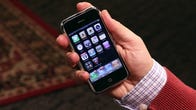We all knew it was coming.
Reporters, analysts, industry insiders and fans had been speculating about Apple making a phone for nearly a year by the time Steve Jobs walked onto the Macworld Expo stage on a cold January morning in San Francisco in 2007.
“Thank you for coming,” Jobs said, wearing his trademark Levi’s and black mock turtleneck. “We’re going to make some history together today.”

Apple’s Steve Jobs introduced the iPhone on Jan. 9, 2007, calling it a “revolutionary and magical product.” The phone went on sale June 29, 2007.
Apple
Despite the months-long buildup, Apple’s CEO managed to surprise the world when he finally unveiled the iPhone — the company’s big, risky move into the mobile phone market.
“This is a day I’ve been looking forward to for two-and-a-half years,” he told the audience of 4,000 people. “Every once in a while a revolutionary product comes along that changes everything. … One is very fortunate if you get to work on just one of these in your career. Apple’s been very fortunate. It’s been able to introduce a few of these into the world.
“In 1984, we introduced the Macintosh. It didn’t just change Apple. It changed the whole computer industry.
“In 2001, we introduced the first iPod and it didn’t just change the way we listened to music. It changed the entire music industry. Well, today we’re introducing three revolutionary products of this class.
“The first one is a widescreen iPod with touch controls,” Jobs said to whoops and cheers while I — sitting on the floor near one of the rare power outlets in the hall — furiously sent out Jobs’ remarks in 83-character, all-cap headlines for Bloomberg News, where I worked as the Apple reporter.
“The second is a revolutionary mobile phone. And the third is a breakthrough Internet communications device. So three things: a widescreen iPod with touch controls, a revolutionary mobile phone and a breakthrough internet communications device.
“An iPod, a phone and an Internet communicator. An iPod, a phone — are you getting it?” he asked the cheering audience.
“These are not separate devices. This is one device. And we are calling it iPhone.
“Today Apple is going to reinvent the phone. … We want to make a leapfrog product that is way smarter than any mobile device has ever been and super easy to use.”
Fifteen years later, we know Jobs was right. Apple did make history on Jan. 9, 2007, when it unveiled one of the most iconic products in consumer electronics history and changed its name from Apple Computer Inc. to Apple Inc. to signal it would no longer just be known for the Mac. More than 2 billion models of the iPhone have been sold since it went on sale June 29, 2007, and it has become the phone of choice for people around the world, with many anticipating a new model every September. It redrew mobile phone design and changed the entire phone industry.
And it pretty much led to the end of standalone music players, GPS receivers and low-end to midrange digital cameras. Just last month, Apple announced it was discontinuing the iPod Touch after 21 years, saying that “the spirit of iPod lives on” in its other devices, including the iPhone and iPad.
Master showman
People always lined up for days outside San Francisco’s Moscone Center to make sure they’d get a seat for the Macworld keynote. And as they camped out on Howard Street, they’d see the press, analysts, Apple executives and other VIPs escorted into Moscone West, where we waited on the top floor of the conference center.
Back then, Apple didn’t open the doors to the hall until 10 minutes before the event started, guaranteeing a frenzied horde of people scrambling for prime spots. By my guess, it takes two minutes for 4,000 people to run into a conference hall and grab a seat. Let’s just say Jobs already had a pretty receptive audience.
And he certainly knew how to play to a room.
A master showman, Jobs kept the crowd of reporters, analysts, developers, employees and Apple fans in a state of anticipation and wonder throughout the nearly two-hour keynote.
He talked first about the move to Intel chips in Macs the year before, saying Mac sales proved that the change over to the new architecture was a success. And he welcomed the loads of “switchers,” who’d jettisoned Windows-based PCs for Macs.
He touted the iPod, introduced more than five years earlier, calling it the world’s most popular music player and the world’s most popular video player (I was there at the launch of the iPod as well.) He got huge laughs from the crowd after cracking a joke about the mediocre launch of Microsoft’s rival Zune player two months before. He played the latest iPod TV ad featuring neon-colored silhouettes of dancers rocking out to Flathead, by indie Glasgow band The Fratellis.
Oh, and he introduced Apple TV.
All the while I sat on the floor and typed out a steady stream of short, all-cap headlines — a kind of primeval Twitter story. By the time Jobs reached the crux of his presentation, my headline only needed 19 characters: “Apple unveils phone.” He’d been on stage for 20 minutes.
The stock chart for Apple looked like a hockey stick just seconds after the news was out.
Aha moment
Apple has always been a magnet for speculation. Almost a year before Jobs stepped on that stage, rumors started flying that Apple was planning to enter the crowded mobile phone market with a cool new device.
Talk turned from “if” to “when” in July 2006, after Peter Oppenheimer, then chief financial officer of Apple, pretty much confirmed the effort during in an earnings call with financial analysts. “We are very confident in our ability to compete in the marketplace, and we are very excited about what we have in the product pipeline,” Oppenheimer said when asked how the company planned to compete against Sony and other rivals.
“As regards cellphones, we do not think that the phones that are available today make the best music players. We think the iPod is. But over time, that is likely to change, and we are not sitting around doing nothing.”
That was an aha moment for financial types, especially since Apple doesn’t make off-the-cuff comments about anything it’s working on. The aha turned into “coming soon” three months later when news broke that Apple had filed a trademark application for iPhone. (Fun fact: Cisco, the networking giant, owned the rights to the iPhone name when Apple launched the phone, but let Jobs have the trademark after reaching a legal settlement a few weeks later.)
Bold promises
It’s hard for many to remember now, but back then few people could imagine how the iPhone’s 3.5-inch touchscreen display and sleek design would upend a market that Nokia and BlackBerry ruled. BlackBerry’s maker, then known as Research In Motion, later admitted it had underestimated the iPhone — dissing it for its eight-hour battery life and belittling it because the phone ran only on AT&T’s older, slower, second-generation wireless network.
“By all rights, the product should have failed,” David Yach, RIM’s chief technology officer, told The Wall Street Journal in May 2015.
I remember the iPhone was a big deal because it was such a big risk for Apple. Up until that day, Apple Computer Inc. was known for its Macs and the iPod. Jobs knew he was staking Apple’s future on getting an even bigger slice of the consumer electronics market. He reinforced that idea when he announced at the end of his keynote that the company was dropping “Computer” from its name and would just be called Apple Inc.

An original Apple iPhone on display during MacWorld in San Francisco, California, on Tuesday, Jan. 9, 2007.
Eric Slomanson/Bloomberg via Getty Images
And he promised that the iPhone, which he called a “revolutionary and magical product that is literally five years ahead of any other mobile phone,” would be a success if Apple could capture even a 1% share of the mobile market in 2008. That would mean selling 10 million iPhones.
The crowd went wild. A financial analyst told me that the iPhone, with its widescreen, full Safari web browser, visual voicemail and the music, photo and video features courtesy of the iPod, was a “complete stunner.” Another told me the 10 million sales figure for 2008 “sounds low.”
Apple beat that 10 million goal by September 2008 – three months ahead of schedule. In July 2016, Apple announced it had sold 1 billion phones since the phone’s launch.
“iPhone set the standard for mobile computing in its first decade and we are just getting started,” Apple CEO Tim Cook said in 2017 in a message commemorating the 10th anniversary of the iPhone. “The best is yet to come.”
Today, Apple is one of the most valuable companies on the planet, with a market capitalization of $2.3 trillion.
The right touch
Here’s what else I remember about the presentation that day.
• Jobs saying “Boy, have we patented it” when he talked about the iPhone’s design and its multitouch technology. He reveled in showing off how easy the phone was to use, calling out the single home button at the bottom of the glass screen. And his comments about patenting the device weren’t just offhand — Apple and its largest smartphone rival, Samsung, would spend seven years in court fighting over Apple’s design in a case that went all the way up to the US Supreme Court.
• Jobs making the first public phone call on the iPhone to Apple’s then chief designer, Jony Ive, who was sitting in the audience. Jobs asked Ive what he thought of the moment. Ive’s reply: “It’s not too shabby.”
• The laughter as Jobs called a local Starbucks, saying “I’d like to order 4,000 lattes to go, please. No, just kidding. Wrong number.”
• The disappointment when Apple didn’t give developers a way to build native apps for the iPhone. (Jobs later changed his mind and decided to open that kind of access to developers, instead of just running web-based apps on the phone. Apple introduced the App Store on July 10, 2008, and paid homage to the store on its 10th anniversary.)
In the years since that launch, I’ve written a lot stories about the new models, about whether Apple can keep churning out designs that make us want to upgrade, and about how the phone changed Apple’s partners, including Corning, AT&T and others. And so I’ll share one of my favorite anecdotes about the iPhone, which comes from Marc Andreessen, who pioneered web browsing with Mosaic and Netscape and is now one of the top venture capitalists in Silicon Valley.
“In the fall of 2006, my wife, Laura, and I went out to dinner with Steve and his brilliant and lovely wife, Laurene,” Andreessen told me in 2012.
“Sitting outside of the restaurant on California Avenue in Palo Alto waiting for a table to open up, on a balmy Silicon Valley evening, Steve pulled his personal prototype iPhone out of his jeans pocket and said, ‘Here, let me show you something.’ He took me on a tour through all of the features and capabilities of the new device.
“After an appropriate amount of oohing and aahing, I ventured a comment. BlackBerry aficionado as I was, I said, ‘Boy, Steve, don’t you think it’s going to be a problem not having a physical keyboard? Are people really going to be OK typing directly on the screen?’
“He looked me right in the eye with that piercing gaze and said, ‘They’ll get used to it.'”
And so we all did.






